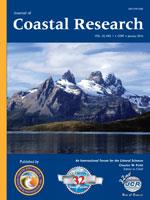Laut, L.L.M.; Martins, V.; da Silva, F.S.; Crapez, M.A.C.; Fontana, L.F.; Carvalhal-Gomes, S.B.V., and Souza, R.C.C.L., 2016. Foraminifera, thecamoebians, and bacterial activity in polluted intertropical and subtropical Brazilian estuarine systems.
This study aims to identify relationships between total organic matter (TOM), bacterial carbon (BC), and metabolic activity in the thecamoebian and foraminifera community of five estuarine regions on the Brazilian coast. Sediment samples were collected from the subtidal zone of five Brazilian estuaries: Potengi, Mataripe Sound, Paraíba do Sul, Suruí, and Itacorubí. A total of 21 thecamoebian species, 29 species of agglutinated foraminifera, and 55 species of calcareous foraminifera were identified. In these estuaries the anaerobic process was dominant. In the Potengi Estuary, located in the NE coast of Brazil, the assemblages showed a decrease in diversity and richness as well as an increase in bacterial carbon concentrations. In the other estuaries the opposite pattern was observed, because they were dominated by agglutinated foraminifera and thecamoebians. Bacterial sulfate-reduction activity promotes acidification of the environment during organic matter degradation, and only calcareous species like Ammonia tepida, Elphidium fimbriatulum, Cribroelphidium poeyanum, Bolivina striatula, Bolivina inflata, and Nonionella opima increase their relative abundance with rising BC and TOM. Miliammina fusca, Haplophragmoides wilberti, and some species of trochamminids are associated positively with bacterial concentrations. Most of the thecamoebians species of genus Difflugia are positively related to BC, but Centropyxis aculeata is more clearly linked with total organic matter.





